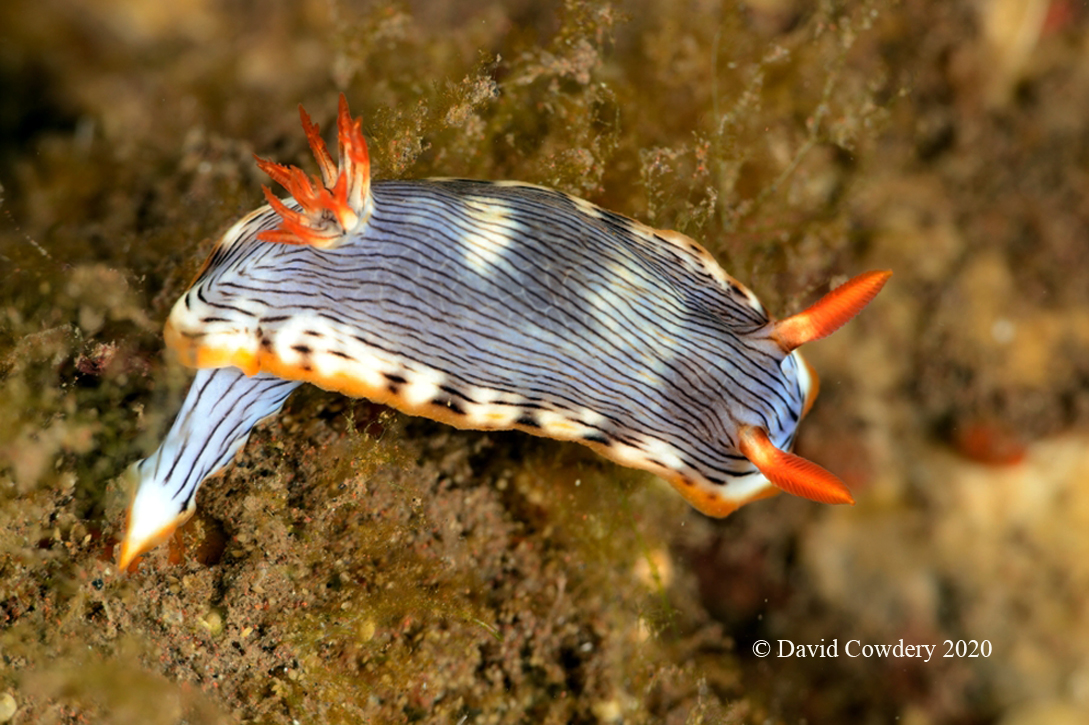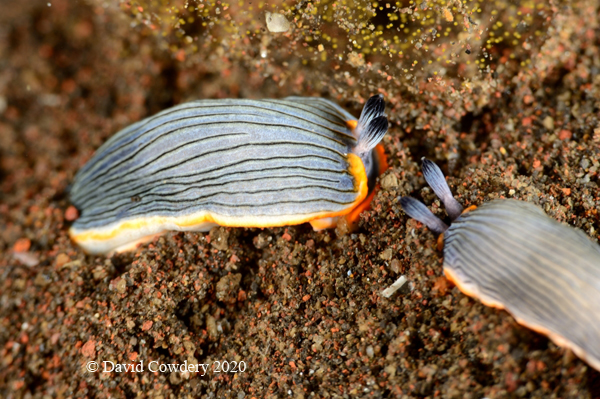 |
Image courtesy of David Cowdery
Seraya Secrets, Tulamben, Bali, Indonesia
|
Dermatobranchus sp. 12 Image courtesy of David Cowdery Seraya Secrets, Tulamben, Bali, Indonesia  |
Mimicry or Coincidence? Chromodoris burni and Dermatobranchus sp. 12. Mr. Cowdery seems to have a huge collection of look-a-like creatures, which he refers to as mimics. Until field experimentation is carried out it is hard to say whether these are actual model/mimic relationships or just coincidence. There needs to be an explainable reason for mimicry, not just looking alike. Mimicry occurs when an organism has evolved a superficial resemblance to another organism in order to gain a selective advantage, ie: avoid the attack of a predator. Scientists recognize two types of mimicry - Batesian mimicry and Mullerian mimicry. Neither of these should be confused with camouflage.
Batesian mimicry is named after its discoverer, Henry Bates, a Victorian explorer and collector of exotic animals. This is the most common type of mimicry where a brightly colored species "the model" has nasty, maybe even poisonous defensive strategies, like chemical secretions or nematocysts. The mimic is an edible species of similar size and color pattern as the model. Predators avoid the mimic because of its aposomatic (warning) coloration. There are many examples where sea slugs are mimicked by non-opisthobranch animals. I am not aware of any examples of the reverse where a sea-slug is the mimic. David's photos here may be an example of Batesian mimicry, as the chromodorid does have defensive secretions form its mantle glands. I am not sure it the arminid has similar defensive strategies, and that is where the issue becomes cloudy. If the arminid does, this may not be Batesian but in fact Mullerian mimicry.. |
I direct you to my Nudibranch Behavior book, pages 151 -153 and 156-157 for examples of Batesian mimics, and Kevin's (BOW model/mimic example).
Mullerian mimicry is a defensive strategy involving two or more noxious species that share similar aposomatic color patterns, as David's examples may be doing. This form of mimicry was named for German zoologist Fritz Muller. It is a "strength in numbers" strategy - the greater the number of similarly colored noxious and unpalatable animals inhabiting the same environment decreases the chance that any one individual will be tasted, by a potential predator. Because neither animal benefits more than the other it is unnecessary to assign the labels model or mimic. Examples of Mullerian mimicry can be found in Nudibranch Behavior, pages 154-155.
So I will leave it up to you - is it mimicry or coincidence? And, if mimicry, which kind - Batesian or Mullerian?
Dave Behrens
Sammamish, WA 98074
Jul., 2020
Send Dave Behrens email at davidwbehrens@gmail.com

Dave Cowdery is a retired bio-medical Engineer and is the inventor of the Alumina/Titanium hermetic feedthrough (1970) for implantable bionics and the first to introduce a Titanium casing. This invention created the first bionic implant (pacemaker) with a service life that could be measured in years rather than months and is the basis for todays huge multi billion dollar bionic industry. David is a Divemaster with over 5,500 dives experience and is based near Byron Bay in Australia. David is also a keen competitive road bicycle rider covering over 400 km most weeks. Photographic equipment used Nikon D800 camera with DS160 substrobes.
Send Dave mail at divec@ozemail.com.au
|

Attention all you Sluggers, and you know who you are! The NSSI 2nd edition is now available in ebook PDF and book form . The hard back version will become available Nov. 1st. Both will cost $65 (individually). You will need to jump through a few hoops to get the electronic version as pdf distribution is protected by Adobe ID!! Please read the following to enable reading your electronic purchase! This new 2nd Edition is updated and reorganized, including 185 new species. Among other features, the new edition includes additional photographs of species, an identification key, and an up-to-date classification reflecting the latest evolutionary relationships. The Indo-Pacific represents the largest expanse of tropical ocean in the world, stretching from the Indian Ocean coast of southern Africa and the Red Sea to the central Pacific of the Hawaiian Islands, Easter Island and the Marquesas. This region supports the most diverse marine fauna of any place in the world for most groups of marine organisms. The nudibranchs and sea slugs are no exception to this rule; there are about 3,000 described species of these organisms in the world and at least 40% of these have been found exclusively in the Indo-Pacific tropics. This book illustrates 2,138 Indo-Pacific nudibranchs and sea slugs, including many undescribed species.
|

|
